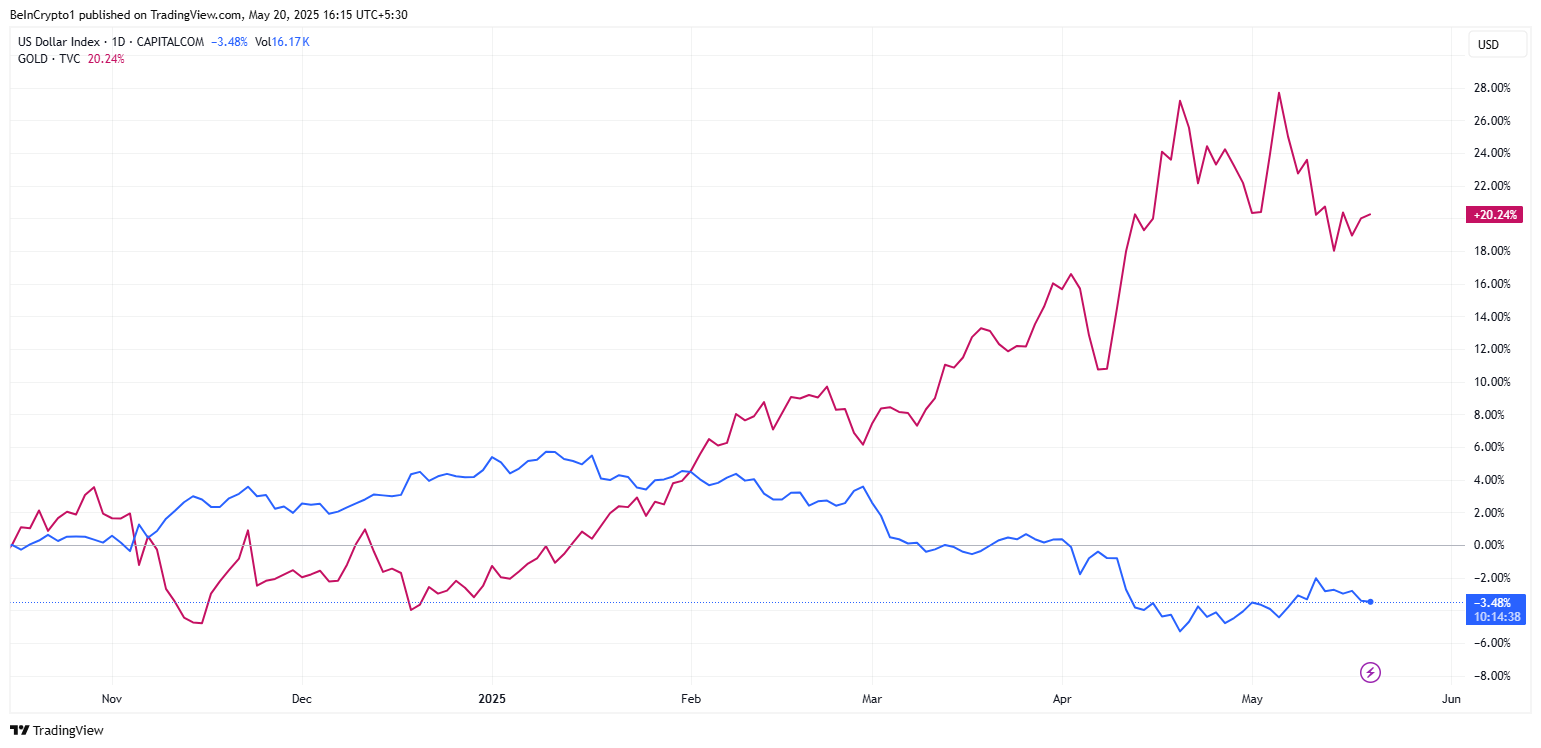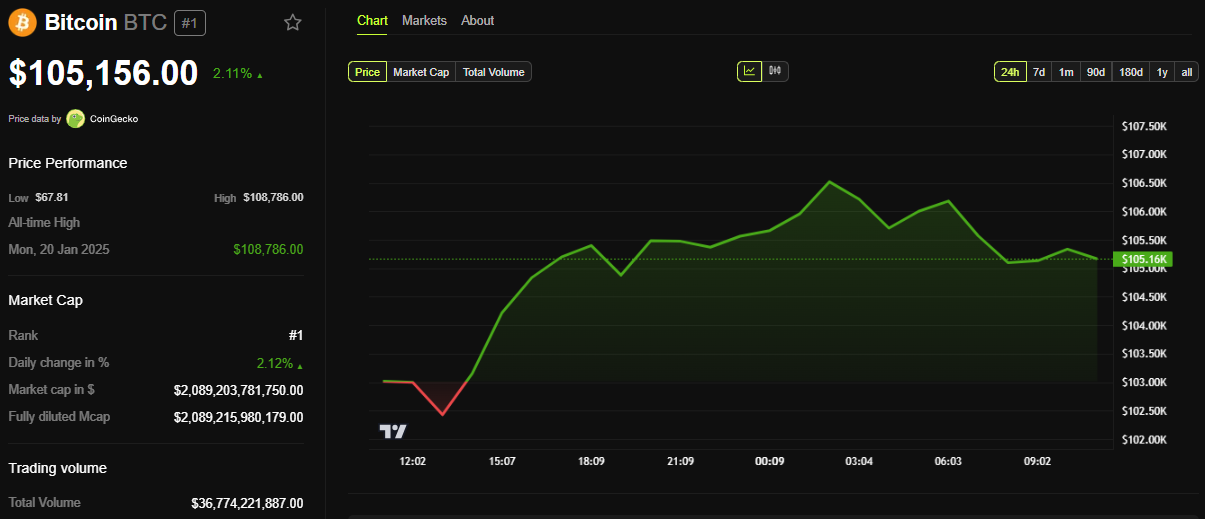| COINOTAG recommends • Exchange signup |
| 💹 Trade with pro tools |
| Fast execution, robust charts, clean risk controls. |
| 👉 Open account → |
| COINOTAG recommends • Exchange signup |
| 🚀 Smooth orders, clear control |
| Advanced order types and market depth in one view. |
| 👉 Create account → |
| COINOTAG recommends • Exchange signup |
| 📈 Clarity in volatile markets |
| Plan entries & exits, manage positions with discipline. |
| 👉 Sign up → |
| COINOTAG recommends • Exchange signup |
| ⚡ Speed, depth, reliability |
| Execute confidently when timing matters. |
| 👉 Open account → |
| COINOTAG recommends • Exchange signup |
| 🧭 A focused workflow for traders |
| Alerts, watchlists, and a repeatable process. |
| 👉 Get started → |
| COINOTAG recommends • Exchange signup |
| ✅ Data‑driven decisions |
| Focus on process—not noise. |
| 👉 Sign up → |
-
As macroeconomic dynamics continue to shift, Bitcoin (BTC) emerges as a prominent alternative amidst growing financial instability, bolstered by China’s recent rate cuts and the US credit downgrade.
-
These interventions by central banks highlight Bitcoin’s growing appeal as a hedge against traditional fiat currencies, positioning it as an attractive investment for risk-averse individuals.
-
According to Axel Adler Jr., “This market environment not only benefits Bitcoin but also reaffirms its status as ‘digital gold.’”
This article explores the latest macroeconomic shifts impacting Bitcoin, highlighting its increasing relevance as a hedging asset amid global financial instability.
Bitcoin Gains from China’s Rate Cut and US Credit Downgrade
On Tuesday, the People’s Bank of China (PBOC) cut its benchmark lending rates for the first time in seven months, signaling a proactive approach to invigorate a slowing economy. The one-year Loan Prime Rate (LPR) was reduced from 3.10% to 3.00% and the five-year LPR from 3.60% to 3.50%.
This move injects fresh liquidity into global markets, aiming to stimulate economic activity hampered by weak domestic demand, while also supporting a struggling real estate sector amid escalating trade tensions with the US.
“The PBOC cut… to support the economy amid slowing growth and US trade pressures. Essentially, this injects additional momentum into risk assets by providing cheaper liquidity and fostering a risk-on sentiment,” noted Axel Adler Jr., an on-chain and macro researcher.
| COINOTAG recommends • Professional traders group |
| 💎 Join a professional trading community |
| Work with senior traders, research‑backed setups, and risk‑first frameworks. |
| 👉 Join the group → |
| COINOTAG recommends • Professional traders group |
| 📊 Transparent performance, real process |
| Spot strategies with documented months of triple‑digit runs during strong trends; futures plans use defined R:R and sizing. |
| 👉 Get access → |
| COINOTAG recommends • Professional traders group |
| 🧭 Research → Plan → Execute |
| Daily levels, watchlists, and post‑trade reviews to build consistency. |
| 👉 Join now → |
| COINOTAG recommends • Professional traders group |
| 🛡️ Risk comes first |
| Sizing methods, invalidation rules, and R‑multiples baked into every plan. |
| 👉 Start today → |
| COINOTAG recommends • Professional traders group |
| 🧠 Learn the “why” behind each trade |
| Live breakdowns, playbooks, and framework‑first education. |
| 👉 Join the group → |
| COINOTAG recommends • Professional traders group |
| 🚀 Insider • APEX • INNER CIRCLE |
| Choose the depth you need—tools, coaching, and member rooms. |
| 👉 Explore tiers → |
While these easing measures target local borrowing and spending, they can have a ripple effect on worldwide asset markets, including cryptocurrencies.
Bitcoin, often regarded as a high-beta asset, traditionally benefits from such liquidity enhancements, particularly during periods of fiat weakness or encompassing economic turmoil.
| COINOTAG recommends • Exchange signup |
| 📈 Clear interface, precise orders |
| Sharp entries & exits with actionable alerts. |
| 👉 Create free account → |
| COINOTAG recommends • Exchange signup |
| 🧠 Smarter tools. Better decisions. |
| Depth analytics and risk features in one view. |
| 👉 Sign up → |
| COINOTAG recommends • Exchange signup |
| 🎯 Take control of entries & exits |
| Set alerts, define stops, execute consistently. |
| 👉 Open account → |
| COINOTAG recommends • Exchange signup |
| 🛠️ From idea to execution |
| Turn setups into plans with practical order types. |
| 👉 Join now → |
| COINOTAG recommends • Exchange signup |
| 📋 Trade your plan |
| Watchlists and routing that support focus. |
| 👉 Get started → |
| COINOTAG recommends • Exchange signup |
| 📊 Precision without the noise |
| Data‑first workflows for active traders. |
| 👉 Sign up → |
In parallel, the United States has encountered its own credibility challenges, as Moody’s downgraded its sovereign credit rating from AAA to AA1. This decision reflects ongoing fiscal deficits and an alarming projection of federal debt, expected to hit 134% of GDP by 2035.
This downgrade is noteworthy, marking the third significant downgrade in US history, following similar actions taken by Fitch in 2023 and S&P in 2011. Nick Drendel, a data integrity analyst, underscored the lingering effects of prior downgrades on market volatility.
| COINOTAG recommends • Traders club |
| ⚡ Futures with discipline |
| Defined R:R, pre‑set invalidation, execution checklists. |
| 👉 Join the club → |
| COINOTAG recommends • Traders club |
| 🎯 Spot strategies that compound |
| Momentum & accumulation frameworks managed with clear risk. |
| 👉 Get access → |
| COINOTAG recommends • Traders club |
| 🏛️ APEX tier for serious traders |
| Deep dives, analyst Q&A, and accountability sprints. |
| 👉 Explore APEX → |
| COINOTAG recommends • Traders club |
| 📈 Real‑time market structure |
| Key levels, liquidity zones, and actionable context. |
| 👉 Join now → |
| COINOTAG recommends • Traders club |
| 🔔 Smart alerts, not noise |
| Context‑rich notifications tied to plans and risk—never hype. |
| 👉 Get access → |
| COINOTAG recommends • Traders club |
| 🤝 Peer review & coaching |
| Hands‑on feedback that sharpens execution and risk control. |
| 👉 Join the club → |
“[The Fitch downgrade in 2023] led to a 74 trading day (-10.6%) correction for the Nasdaq before concluding above the pre-downgrade close,” Drendel explained.
This recent downgrade intensifies existing concerns surrounding substantial debt levels, political standstill, and increasing default risks.
Moody’s Downgrade, US Fiscal Woes Boost Bitcoin’s Safe-Haven Appeal
On-chain analyst Adler pointed out the immediate consequences of the downgrade. The US Dollar Index (DXY) fell to 100.85, while gold prices rose 0.4%, indicating typical flight-to-safety behavior among investors.

| COINOTAG recommends • Exchange signup |
| 📈 Clear control for futures |
| Sizing, stops, and scenario planning tools. |
| 👉 Open futures account → |
| COINOTAG recommends • Exchange signup |
| 🧩 Structure your futures trades |
| Define entries & exits with advanced orders. |
| 👉 Sign up → |
| COINOTAG recommends • Exchange signup |
| 🛡️ Control volatility |
| Automate alerts and manage positions with discipline. |
| 👉 Get started → |
| COINOTAG recommends • Exchange signup |
| ⚙️ Execution you can rely on |
| Fast routing and meaningful depth insights. |
| 👉 Create account → |
| COINOTAG recommends • Exchange signup |
| 📒 Plan. Execute. Review. |
| Frameworks for consistent decision‑making. |
| 👉 Join now → |
| COINOTAG recommends • Exchange signup |
| 🧩 Choose clarity over complexity |
| Actionable, pro‑grade tools—no fluff. |
| 👉 Open account → |
Bitcoin, often referred to as digital gold, saw a resurgence of interest as a non-sovereign store of value.
“…despite the prevailing ‘risk-off’ sentiment… Bitcoin may find itself in a relatively stronger position in the current environment due to its ‘digital gold’ narrative and the supportive effect of a weaker dollar,” Adler highlighted.
| COINOTAG recommends • Members‑only research |
| 📌 Curated setups, clearly explained |
| Entry, invalidation, targets, and R:R defined before execution. |
| 👉 Get access → |
| COINOTAG recommends • Members‑only research |
| 🧠 Data‑led decision making |
| Technical + flow + context synthesized into actionable plans. |
| 👉 Join now → |
| COINOTAG recommends • Members‑only research |
| 🧱 Consistency over hype |
| Repeatable rules, realistic expectations, and a calmer mindset. |
| 👉 Get access → |
| COINOTAG recommends • Members‑only research |
| 🕒 Patience is an edge |
| Wait for confirmation and manage risk with checklists. |
| 👉 Join now → |
| COINOTAG recommends • Members‑only research |
| 💼 Professional mentorship |
| Guidance from seasoned traders and structured feedback loops. |
| 👉 Get access → |
| COINOTAG recommends • Members‑only research |
| 🧮 Track • Review • Improve |
| Documented PnL tracking and post‑mortems to accelerate learning. |
| 👉 Join now → |
Critically, Ray Dalio, founder of Bridgewater Associates, has voiced concerns about credit ratings not adequately reflecting broader monetary risks.
“…they only rate the risk of the government not paying its debt. They don’t include the greater risk that countries in debt will print money to pay their debts, thus causing holders of the bonds to suffer losses from the decreased value of the money they’re getting,” Dalio warned.
| COINOTAG recommends • Exchange signup |
| 🎯 Focus on process over noise |
| Plan trades, size positions, execute consistently. |
| 👉 Sign up → |
| COINOTAG recommends • Exchange signup |
| 🛠️ Simplify execution |
| Keep decisions clear with practical controls. |
| 👉 Get started → |
| COINOTAG recommends • Exchange signup |
| 📊 Make data your edge |
| Use depth and alerts to avoid guesswork. |
| 👉 Open account → |
| COINOTAG recommends • Exchange signup |
| 🧭 Be prepared, not reactive |
| Turn setups into rules before you trade. |
| 👉 Create account → |
| COINOTAG recommends • Exchange signup |
| ✍️ Plan first, then act |
| Entries, exits, and reviews that fit your routine. |
| 👉 Join now → |
| COINOTAG recommends • Exchange signup |
| 🧩 Consistency beats intensity |
| Small, repeatable steps win the long run. |
| 👉 Sign up → |
Dalio’s analysis suggests that the risks faced by US government debt could be greater than what rating agencies convey.
In support, economist Peter Schiff stressed the importance of factoring inflation risk when gauging sovereign debt, especially when a significant portion is held by foreign investors lacking political leverage.
| COINOTAG recommends • Premium trading community |
| 🏛️ WAGMI CAPITAL — Premium Trading Community |
| Strategic insights, exclusive opportunities, professional support. |
| 👉 Join WAGMI CAPITAL → |
| COINOTAG recommends • Premium trading community |
| 💬 Inner Circle access |
| See members share real‑time PnL and execution notes in chat. |
| 👉 Apply for Inner Circle → |
| COINOTAG recommends • Premium trading community |
| 🧩 Turn theses into trades |
| Reusable templates for entries, risk, and review—end to end. |
| 👉 Join the club → |
| COINOTAG recommends • Premium trading community |
| 💡 Long‑term mindset |
| Patience and discipline over noise; a process that compounds. |
| 👉 Get started → |
| COINOTAG recommends • Premium trading community |
| 📚 Education + execution |
| Courses, playbooks, and live market walkthroughs—learn by doing. |
| 👉 Get access → |
| COINOTAG recommends • Premium trading community |
| 🔒 Members‑only research drops |
| Curated analyses and private briefings—quality over quantity. |
| 👉 Join WAGMI CAPITAL → |
“…when a nation owes a lot of debt to foreigners, who can’t vote, the odds of a default on foreign-owned debt should be factored in,” he noted.
This dual macroeconomic scenario—China injecting liquidity and the US revealing fiscal vulnerabilities—positions Bitcoin favorably. Historically, Bitcoin has thrived amid conditions of rising inflation fears and weakened fiat trust, attracting global capital looking for resilient alternatives.
| COINOTAG recommends • Exchange signup |
| 🧱 Execute with discipline |
| Watchlists, alerts, and flexible order control. |
| 👉 Sign up → |
| COINOTAG recommends • Exchange signup |
| 🧩 Keep your strategy simple |
| Clear rules and repeatable steps. |
| 👉 Open account → |
| COINOTAG recommends • Exchange signup |
| 🧠 Stay objective |
| Let data—not emotion—drive actions. |
| 👉 Get started → |
| COINOTAG recommends • Exchange signup |
| ⏱️ Trade when it makes sense |
| Your plan sets the timing—not the feed. |
| 👉 Join now → |
| COINOTAG recommends • Exchange signup |
| 🌿 A calm plan for busy markets |
| Set size and stops first, then execute. |
| 👉 Create account → |
| COINOTAG recommends • Exchange signup |
| 🧱 Your framework. Your rules. |
| Design entries/exits that fit your routine. |
| 👉 Sign up → |
As markets remain volatile, the convergence of dovish policies in China and skepticism regarding US fiscal integrity could entice both institutional and retail investors toward decentralized assets like Bitcoin.
If the dollar continues to weaken and central banks maintain lenient policies, Bitcoin’s value proposition as a politically neutral, non-inflationary asset will become increasingly apparent.

COINOTAG data indicates BTC was trading at $105,156 at the time of writing, reflecting a modest surge of 2.11% over the last 24 hours.
Conclusion
In summary, the combined impact of China’s economic measures and the US’s credit downgrade substantially enhances Bitcoin’s narrative as a hedge against financial uncertainty. As vulnerabilities in traditional finance mount, Bitcoin’s intrinsic qualities are drawing increasing interest from diverse investor bases.
| COINOTAG recommends • Members‑only research |
| 📌 Curated setups, clearly explained |
| Entry, invalidation, targets, and R:R defined before execution. |
| 👉 Get access → |
| COINOTAG recommends • Members‑only research |
| 🧠 Data‑led decision making |
| Technical + flow + context synthesized into actionable plans. |
| 👉 Join now → |
| COINOTAG recommends • Members‑only research |
| 🧱 Consistency over hype |
| Repeatable rules, realistic expectations, and a calmer mindset. |
| 👉 Get access → |
| COINOTAG recommends • Members‑only research |
| 🕒 Patience is an edge |
| Wait for confirmation and manage risk with checklists. |
| 👉 Join now → |
| COINOTAG recommends • Members‑only research |
| 💼 Professional mentorship |
| Guidance from seasoned traders and structured feedback loops. |
| 👉 Get access → |
| COINOTAG recommends • Members‑only research |
| 🧮 Track • Review • Improve |
| Documented PnL tracking and post‑mortems to accelerate learning. |
| 👉 Join now → |









